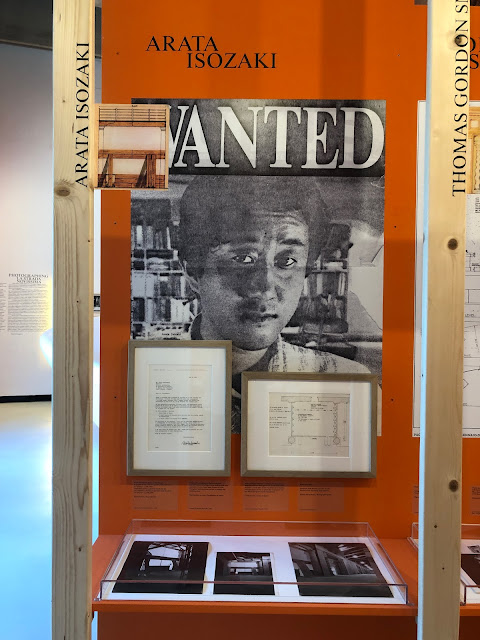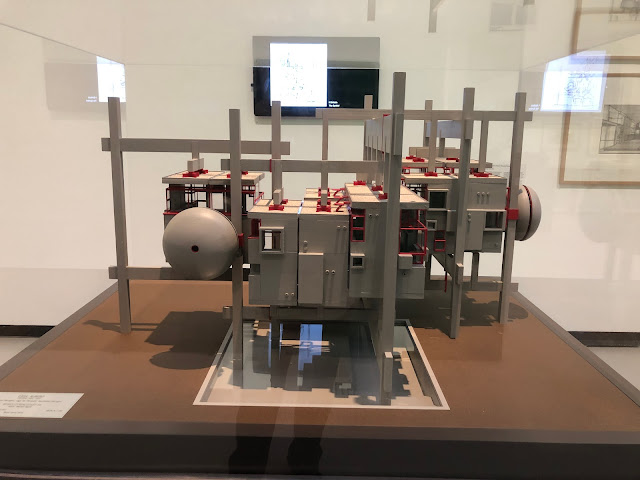【ローマ】国立21世紀美術館(MAXXI)建築の展示 Roma - Museo Nazionale delle Arti XXI Secolo (MAXXI), Architectural display
この美術館は、ザハがその建物を設計していることもあり、いわゆる絵画や彫刻、映像作品の他にも、建築についての展示も充実していた。
21世紀の建築家のレジェンドたちについても、その一角にコンパクトな形で紹介されていた。
東京オペラシティなどの設計で知られる磯崎新。
磯崎新は、イタリアではトリノのパラスポーツ・オリンピコや、ミラノのシティライフ・アリアンツ・タワーなどを設計している。
The building of this museum was designed by Zaha, so in addition to so-called paintings, sculptures, and video works, there were also exhibits on architecture.
Legends of 21st century architects were also introduced in a compact form in one corner.
Arata Isozaki is known for designing Tokyo Opera City.
In Italy, Arata Isozaki designed the Parasport Olimpico in Turin and the City Life Allianz Tower in Milan.
ビルバオのグッゲンハイム美術館などの奇抜なデザインで知られているフランク・ゲーリー。
ゲーリーの設計した建物は、ほとんどがアメリカにあり、ヨーロッパではドイツ、スペイン、フランスなどにはあるが、イタリアではこれといった作品はない。
Frank Gehry is known for his eccentric designs such as the Guggenheim Museum in Bilbao.
Most of Gehry's buildings are in the United States, and in Europe there are in Germany, Spain, France, etc., but there are no outstanding works in Italy.
また建築に関する企画展として、At Home 20.20という展覧会も開催されていた。
色々な建築家たちによる、様々な住宅についてのプロジェクトが紹介されていた。
この美術館の建物を設計したザハの他に、ヴェネツィア出身のカルロ・スカルパ、日本の西沢立衛などのプロジェクトも紹介されていた。
An exhibition called At Home 20.20 was also held as a special exhibition on architecture.
A variety of housing projects by various architects were introduced.
In addition to Zaha, who designed the building of this museum, the projects of Carlo Scarpa from Venice and Ryue Nishizawa from Japan were also introduced.
イタリアの建築家と言えば、古代ローマやルネサンス、バロック期は除いて、真っ先に思い浮かぶのはアントニオ・サンテリアの名前だ。
サンテリアは、1888年にイタリアの北部コモで生まれ、その後、ミラノのブレラ美術学校の建築コースで建築を学んだ。
1913年にミラノで結成された建築家集団ヌオーヴォ・テンデンツェ(新傾向)に加わって、その翌年の1914年に行われた展覧会で衝撃的なドローイング「チッタ・ヌオーヴァ(新しい都市)」や「発電所」などを展示し、同時に「未来派建築家宣言」を発表した。
サンテリアのドローイングを、かつてセゾン美術館で行われた未来派展で目にした時の衝撃は、今も鮮明に覚えている。
サンテリアの作品は、一緒に展示されていた、ボチョーニ、セルヴィーニ、カッラ、バッラといった未来派の画家たちの作品を凌駕するような、強烈な存在感を示していた。
Antonio Sant'Elia is the first name that comes to mind when talking about Italian architects, with the exception of the Roman, Renaissance and Baroque periods.
Sant'Elia was born in 1888 in Como, northern Italy, and later studied architecture at the Brera Art School in Milan.
In 1913, he joined the architectural collective Nuovo Tendenze (New Tendency), which was formed in Milan, and in the following year, in 1914, he exhibited shocking drawings such as "Citta Nuova (New City)" and "Power Generation." At the same time, he announced the Futurist Architect Manifesto.
I still vividly remember the shock I felt when I saw Sant'Elia's drawings at the Futurist exhibition held at the Sezon Museum of Art.
Sant'Elia's work had a strong presence that surpassed that of Futurist painters such as Boccioni, Servini, Carra, and Balla, who were also exhibited.







コメント
コメントを投稿